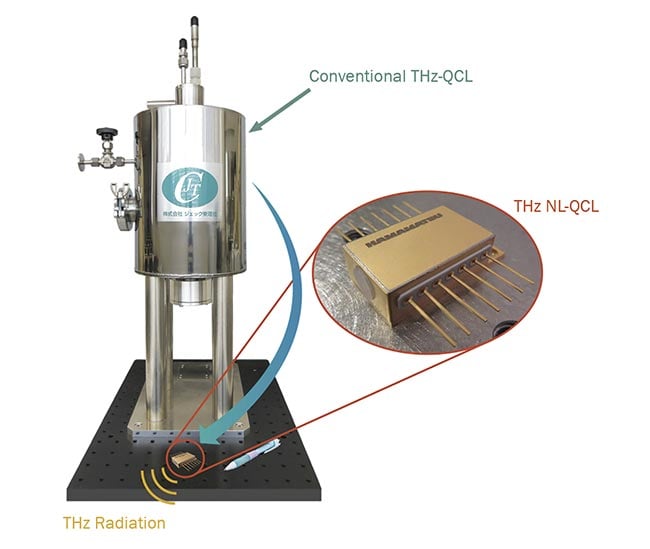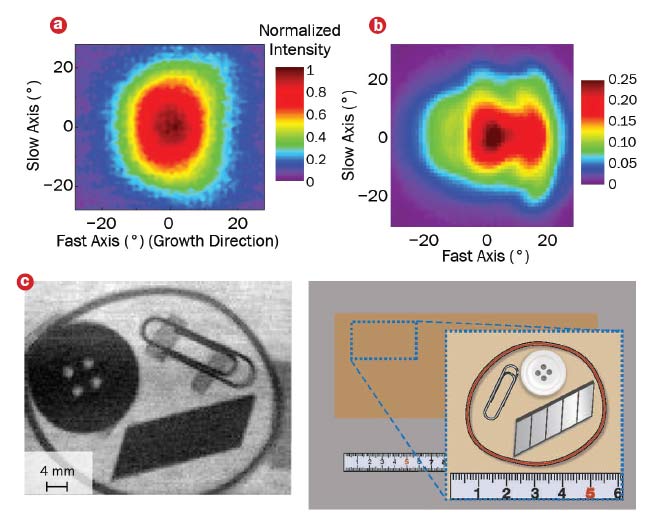A new low-frequency terahertz source shows promise as a simpler, less expensive option for terahertz applications.
KAZUUE FUJITA AND KAZUKI HORITA, HAMAMATSU PHOTONICS, AND STEPHANIE BUTRON, HAMAMATSU CORP.
The terahertz (THz) spectral range between the infrared and microwave has long been recognized as an unexploited range of frequency bands. It has considerable potential for application in numerous
fields, including communications, imaging, spectroscopy, and biological engineering since the THz wave can pass through nonconducting materials such as many dielectric materials, semiconductors, and medicines. Unlike x-ray radiation with its ionizing properties, THz radiation is nonionizing and nondestructive with low
photon energies, making it safer for humans. However, widespread commercialization of THz technology has not yet
been realized due to the lack of a compact, widely tunable, high-performance, and mass-producible THz source. In particular, in the frequency range around 1 THz (which is the center of the THz gap), there are no convenient and inexpensive room-temperature sources applicable to any THz fields.
Kazuue Fujita and his colleagues at the
Central Research Laboratory (CRL) of Hamamatsu Photonics (Japan) have accomplished a major breakthrough in THz generation. The group succeeded in creating a room-temperature, electrically pumped,
subterahertz quantum cascade laser (QCL) that bridges the deepest part of the terahertz gap. This QCL has been recorded to output the longest wavelength of all electrically pumped, monolithic semiconductor lasers.
The team’s technique relies on QCLs, which have structures that consist of periodic and alternating semiconductor layers.
These layers form a series of coupled quan-
tum wells and barriers with a repeated structure. When an external voltage is applied, electrons are transported in the stepped potential wells of the layers, and then transferred into the next structure. Photons are generated between the designed upper and lower levels at each stage. Because transition energy between the levels is low, photon emissions occur in the mid- or far-infrared (terahertz) spectral range. Mid-infrared (mid-IR) QCLs have been demonstrated in continuous-wave operation above room temperature in the 3- to 11-μm spectral range.
On the other hand, the operating frequency range of conventional THz-QCLs spans from 1.2 to 5.4 THz, after the first demonstration in 2001. However, the THz-QCL performance on the low-frequency side has been quite limited in terms of output power as well as the maximum operating temperature. Furthermore, progress toward the development of THz-QCLs that emit at frequencies below 1 THz has been difficult because poor electron injection efficiency from the injector in the upper laser state typically results in extreme difficulty obtaining population inversion for laser action.
The breakthrough approach
The method used to overcome this difficulty is frequency down-conversion using high-power, mid-IR QCLs with high nonlinearity. In a single QCL operating at two closely spaced frequencies, through the nonlinear effect of difference-frequency mixing, those two frequencies interact in the active region material and generate terahertz radiation at a frequency equal to the difference between the two operational frequencies. This device is called THz nonlinear (NL) QCL or THz difference-frequency generation (DFG) QCL1. It is currently the only electrically driven, monolithic semiconductor light source that is capable of room-temperature operation in the THz spectral range (Figure 1).

Figure 1. Operating temperature of QCLs as a function of the emission wavelength or frequency, top axis (top). THz DFG can be achieved in mid-IR QCLs operating between 6 and 15 μm. A schematic of a THz NL-QCL (bottom). Courtesy of Hamamatsu Photonics.
Although difference-frequency generation sources have been demonstrated to produce terahertz radiation in optical nonlinear crystals, that approach requires much larger lasers and bulky optical laser setups. Currently, THz NL-QCLs have expanded spectral coverages that extend over nearly the entire 1- to 6-THz range, assisted by an external cavity setup. However, performance of THz NL-QCLs on the low frequency side (<2 THz) has been significantly limited; this is because THz generation efficiency is principally limited by the high absorption in the waveguide and the reduction of the conversion efficiency from mid-IR power.
Fujita and his colleagues have now broken the record for lowest THz frequency emission from a single THz-QCL and, therefore, semiconductor laser, as reported in Nanophotonics2. They have developed high-performance, sub-THz, and THz NL-QCLs working at room temperature. The drastic progress of this technology is achieved by the introduction of an innovative concept, “dual-upper-state active region design.” Also called the DAU active region design3, this is a quantum structure in the active region of a QCL, which was invented by CRL initially for the development of broadband mid-IR QCLs.
They discovered that the DAU design was responsible for dramatic improvements in the conversion efficiency for THz generation4. So far, for the THz NL-QCL, two sets of the active region stacks were optimized to emit two mid-IR frequencies. For the DAU active region, the additional upper lasing level provided even more optical transition channels for stimulated emission so that the gain bandwidth of a single DAU active region could be twice as broad as previously used in single-
upper-state active region designs (Figure 2). Thus, when distributed feedback gratings for two-frequency operation were fabricated in THz NL-QCLs, the active region stack approach was not required for the DAU active region. Furthermore, the DAU active region was able to reduce optical absorption in its layer structure due to the electron transport dynamics. This resulted in high-performance, long-wavelength mid-IR QCLs with maximum output powers in the 13- to 14-μm range.

Figure 2. Working principle of active region structures for THz NL-QCLs. Standard single-upper-state active region (left). Dual-upper-state active region (right). Courtesy of Hamamatsu Photonics.
The long-wavelength mid-IR QCLs in which wide quantum wells were used for the active region were able to incorporate much higher optical nonlinearity for wavelength conversion for THz radiation. Eventually, these effects worked synergistically, resulting in CRL achieving a new record of operation frequency of THz semiconductor lasers and, based on the same DAU active region, successfully fabricating QCLs that produce THz waves at wavelengths of 1.1 THz, 1.4 THz, and 2.4 THz. The team at Hamamatsu Photonics expects to cover most of the THz frequency range using this technology.
Real-world THz applications
In addition to broader operation frequency coverage, an essential feature of THz NL-QCLs is room-temperature operation. Conventional THz-QCLs typically require cryogenic cooling, which consists of substantially cumbersome packages. These types of cooled QCLs must be operated within controlled environments because their operating temperatures cannot usually be reached via standard thermoelectric cooling. In contrast, THz NL-QCLs that can operate at room temperature could realize drastic downsizing of their packages (Figure 3), and as a result, be incorporated into technologies used for real-world applications as a key component.

Figure 3. Conventional THz-QCLs require low-temperature cooling, while the THz NL-QCL is downsized and operates at room temperature. Courtesy of Hamamatsu Photonics.
Furthermore, another distinct advantage of THz NL-QCLs over conventional THz-QCLs is their single-lobed Gaussian beam profiles (Figure 4a)5. This development makes these QCLs easier to couple into corresponding optics than their conventional counterparts. In conventional THz-QCLs, controlling the beam profile can be a highly challenging problem due to the design limitation of mode confinement. On the other hand, THz radiation of THz NL-QCLs is out-coupled from their semiconductor substrate with large aperture against the wavelength, relying on
Cherenkov phase matching conditions. As a result, the beam profiles of THz NL-QCLs inherently show high-quality, Gaussian-like shapes that are suitable for THz imaging applications. In fact, in most THz imaging systems, the THz beam is refined by passing it through a spatial filter, which is used for enhancing image features. However, in the imaging system with THz NL-QCLs, a spatial filter is not necessary thanks to the superior beam profile. In fact, using an optical setup, the team at Hamamatsu Photonics has performed the first THz imaging experiment with THz NL-QCLs with broadband emission spectra around 2.4 THz at room temperature. Through this, the team achieved well-resolved, high-contrast images of objects obscured by opaque materials (Figure 4b)5.

Figure 4. A far-field beam profile of a Hamamatsu THz NL-QCL at −30 °C (a) and a conventional metal-metal THz QCL (b). A typical terahertz image of small articles in a paper envelope obtained with a THz NL-QCL (TEC temperature) — a rubber band, plastic button, paper clip, and cutter knife blade (c). Courtesy of Hamamatsu Photonics.
The developed THz NL-QCLs are expected to be useful in many applications such as quality testing and nondestructive inspection for identifying purity of pharmaceutical raw materials or intermediary compounds, in which the difference in the material components can be detected based on the spectral contrast of absorption. Other possible applications include submillimeter astronomy and THz communication. Astronomers investigate the birth and formation process of stars by observing interstellar gases, which produce THz radiation; in this field, THz NL-QCLs can be used as a local oscillator. Also, THz frequency bands are anticipated to be useful in wireless communications since there are numerous potentials for high-speed and high-capacity communications over short distances, such as within a home, office, or data center.
Summary
This breakthrough in THz generation is a development the THz research field has been seeking for years. Whether it is due to high costs, square footage required, or the need for professionals trained to handle cryogenic coolants, cooling has limited the implementation of THz sources and detectors in many applications. For example, the cooling equipment’s size and weight, and the added weight of the coolant itself, have prevented THz techniques from being employed in space-based measurements.
The THz QCL, despite this limitation, has excelled in continuous-wavelength
coverage compared to competitive technologies. In overcoming this cooling limitation,
the THz NL-QCL becomes a more viable option for low-frequency THz generation at room temperature. Not only is it compact and mass-producible, but it is also more user-friendly in optical design, it is more convenient to integrate into existing setups, and it showcases higher performance than existing THz QCLs.
However, more must be done if this device is to become highly sought after — especially for applications such as material analysis, wireless communications, trace gas analysis, medical imaging,
and identification of pharmaceutical raw
materials. In addition to improving room-temperature operability, output powers
must be increased. To do so, Hamamatsu Photonics plans to further improve the QCL structure’s design to obtain
continuous-wave operation with constant light output intensity.
Meet the authors
Kazuue Fujita, Ph.D., is a senior research scientist (associate) at Central Research Laboratory, Hamamatsu Photonics K.K., Japan. He is responsible for the research and development of terahertz sources based on quantum cascade lasers. He has a doctorate in electronic engineering from Kyoto University and more than 17 years of expertise in mid-infrared and terahertz technologies; email: [email protected].
Kazuki Horita is a researcher at Central Research Laboratory, Hamamatsu Photonics K.K., Japan. He is responsible for the development and application of terahertz spectroscopy
and sensing. He received a Master of Engineering degree in applied physics from the University of Fukui in 2012 and has more than
10 years of expertise in terahertz technologies; email: [email protected].
Stephanie Butron is an applications
engineer with the Research Innovation Group at Hamamatsu Corp. She is responsible for market, application, and technical research of terahertz and mid-infrared technologies from both university and industrial perspectives. She received a B.S. in chemical engineering from Manhattan College; email: [email protected].
References
1. K. Fujita et al. (2018). Recent progress in terahertz difference-frequency quantum cascade laser sources. Nanophotonics,
Vol. 7, Issue 11, pp. 1795-1817.
2. K. Fujita et al. (2019). Sub-terahertz and terahertz generation in long-wavelength quantum cascade lasers. Nanophotonics, Vol. 8, Issue 12, pp. 2235-2241.
3. K. Fujita et al. (2010). High-performance, homogeneous broad-gain quantum cascade lasers based on dual-upper-state design. Appl Phys Lett, Vol. 96, Issue 24, p. 1107.
4. K. Fujita et al. (2015). Terahertz generation in mid-infrared quantum cascade lasers with a dual-upper-state active region. Appl Phys Lett, Vol. 106, Issue 25, p. 1104.
5. A. Nakanishi et al. (2019). Terahertz imaging with room-temperature terahertz difference-frequency quantum-cascade laser sources. Opt Express, Vol. 27, Issue 3, pp. 1884-1893.